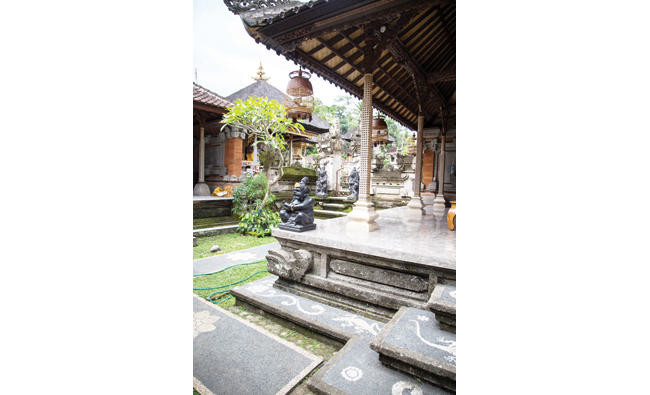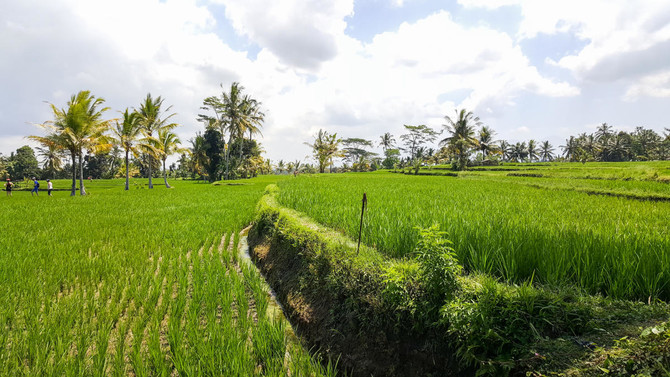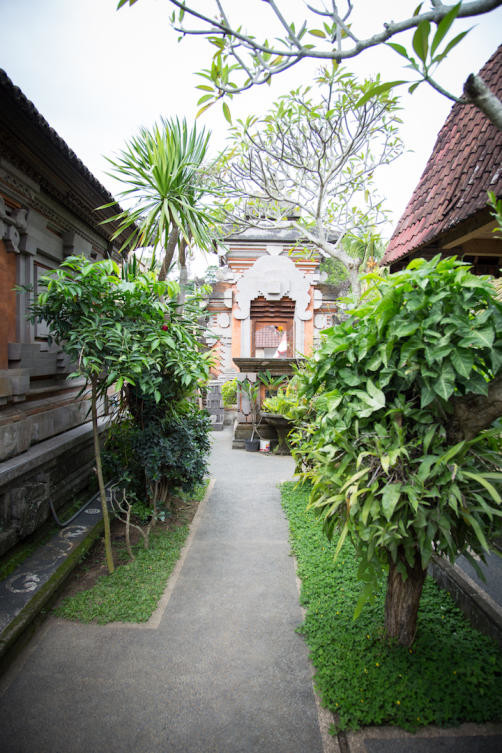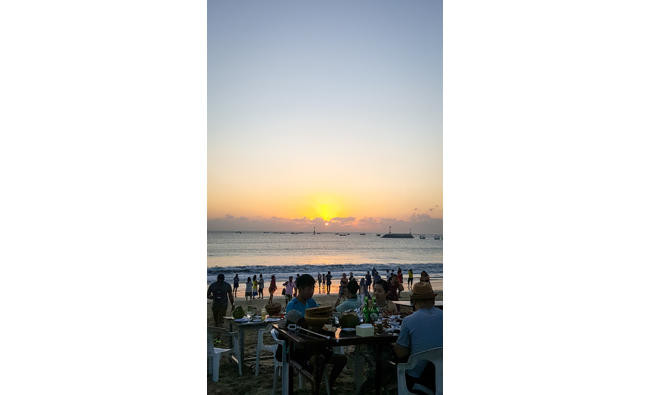Last fall, I spent about two weeks in Bali, an incredibly beautiful and trendy Indonesian island. While this does seem like a long stretch to spend in one place — traffic during peak travel season is horrific — so this is a good amount of time to really appreciate the Balinese way of life without getting too frustrated!
One of the best things about the island is that you can choose to experience many different kinds of activities. You can spend your days on the beach in Seminyak, hang out with monkeys in a forest in Ubud, hike up an active volcano, visit local temples, or if you want a more low-key experience, just hide away in one of the exclusive resorts in Nusa Dua. Spending a couple of days in various parts of the island is quite common as well to avoid traffic.
Of course, the list of things to do in Bali is endless, and there are some others that could easily be added, but these were just a few of the activities that I thought were very much worth the nine-hour slightly bumpy direct flight from Doha on Qatar Airways.
Dine at Ku-De-Ta
This is a fabulous restaurant to eat at when it comes to good food and the views of the ocean, especially at sunset. The venue masters the art of indoor/outdoor dining with a simple interior that is surrounded by hanging vines, palm trees and the calm sound of the waves. It really allows you to fully appreciate Bali’s natural beauty. And if you enjoy a more party-like scene, the outdoor lounging sofas on the patio, the pool at the edge of the restaurant, the second floor sunset balcony, and the live music will take the ambiance to a whole new level.
Hike up Mount Batur to see a gorgeous sunrise
I’ll be honest, this was not the easiest hike for me, but I would do it again in a second. You will definitely need a guide to do this since you start your hike at around 3:30 a.m. and have to navigate the mountain in the dark so that you can make it to the top just in time for sunrise. While I do work out a couple of times a week as well, this felt a little like being on an exercise machine for 2.5 hours. Looking back though, I think the experience would have been a lot easier with some good hiking shoes. And did I mention that this is an active volcano? Luckily, my husband forced me to keep climbing even when I felt like giving up, and I am glad that he did. The opportunity to see the start of a whole new day from the top of the mountain was the most surreal experience for me, and by far my favorite in Bali.
Bike down Mount Batur
A 25-kilometer bike ride sounds challenging, but a downhill 25-kilometer bike ride is very easy and a lot of fun. We did this tour with a larger group and with a guide, which was great as he was able to take us to some of the more inaccessible areas to show us the tiered magnificence of the paddy rice fields. I especially enjoyed the opportunity to ride through narrow local streets, passing the charming homes and temples, and high fiving little children coming home from school as we whizzed past them. It was a little nerve-wracking when we started weaving through local traffic on a busy road, but everyone made it seem so normal that I convinced myself that it was too.
Try a food safari in Seminyak
I highly recommend this to foodies, as it is a great way of discovering some of the trendiest restaurants in town. The other advantage of the food tour is that you get to try many different types of cuisines, all in one night. While there are food tours in other parts of the island, I thought Seminyak had amazing restaurants. Make sure to come with a big appetite — it is going to be a lot of food.
Spend the day in Ubud’s local market for cheap finds
I could have spent a lot of time here, but when my husband realized how heavily discounted all the items were, he quickly encouraged us to finish up quickly. In general, though, shopping in Bali is amazing with wonderful unique finds. Some of my favorite things in the market were the straw woven totes, bamboo purses, clothing and linens made out of colorful Batik fabric, and the mother-of-pearl and shell boxes and trays. This market also has other decorative items made out of real wood and ceramics. If you’re not a fan of the prices they’re offering, this is definitely the place to haggle too! Start off at half of the price that they tell you, and then work your way to a price you’re willing to pay.
Eat seafood at Jimbaran Bay
I absolutely loved Balinese and Indonesian food, and on top of that, their seafood is phenomenal. While I think that there are a lot of wonderful restaurants that are known for their sunset views, this is a very special kind of experience as you’re watching the sunset while eating seafood right on the beach! You may not need to book early at a restaurant, but make sure you show up early enough to get a good table on the beach.
Visit a traditional Balinese home
Balinese people are Hindu, and have a very different and interesting structure to their homes. The architecture is built around their religious and strong cultural beliefs, and is quite unlike any of the Western-style homes that most of us are used to seeing.
Each family residence is essentially a compound with families who cohabit the space, but in completely different quarters surrounding a larger courtyard. The various structures also include a family temple that sits within its own enclosure. I loved seeing the architecture of these homes, especially the beautiful, lush greenery all throughout the home as well as at the entrance. And to top it all off, our host cooked us my favorite Balinese dish, nasi goreng.
In general, the Balinese way of life seems to promote a sense of calm and serenity throughout the home and in life. Most people are incredibly relaxed about their day-to-day activities and run on their own kind of time — “Bali” time or “whenever I feel like it” time.
It’s an addictive type of lifestyle, and one that left a lasting impression on me.
• [email protected]
Seven hip things to do in Bali
Seven hip things to do in Bali

Review: A visit to AlUla’s ancient kingdom ‘Wadi Al-Naam’

- Exploration was organized in groups of three riding in desert buggies to reach the hiking location
The Quest for the Ancient Kingdoms is a thrilling treasure hunt and adventure experience in AlUla’s Wadi Al-Naam, also known as the Valley of the Ostriches.
Before the journey begins, participants are provided with helmets, gloves, and hiking sticks, and are treated to a short lesson about the valley by the tour guide.
During our visit, the guide did a wonderful job making the group feel comfortable and translating the lesson from Arabic to English.
Exploration was organized in groups of three riding in desert buggies to reach the hiking location.
The buggy ride is a great chance to enjoy the iconic orange-hued rocks and mountains of AlUla.
At the first stop, participants can get a closer look at the fine details of inscriptions that tell the story of the Dadanites, the ancient residents of AlUla.
The 500-meter-long hike features various obstacles, like climbing up walls and steep steps, while offering breathtaking views of the unforgettable AlUla terrain.
Participants can choose between the Challenge Edition for adult adventurers or the Family Explorers version for a lighter experience. The treasure hunts are ideal for family or friend groups who want to get active during their trip to AlUla.
The quest concludes with a certificate of completion, refreshments, and a chance to interact with camels.
The best part of the experience is connecting with new individuals and putting your heads together to problem-solve as a team to win the quest.
Before going on this journey, please ensure you apply sunscreen, wear comfortable shoes, and stay hydrated as it will involve physical strength and energy to enjoy.
The Wadi Al-Naam Discovery tour costs SR200 ($53) per person and will be open until Feb. 27.
For more details, visit experiencealula.com.
UK, Omani princes launch journey across historic Arabian route

- Camel trek first taken by British diplomat Bertram Thomas in 1928 to be retrodden by team of six travellers
- Prince of Wales, crown prince of Oman sponsoring historic coastal journey
LONDON: A group of explorers, backed by royalty, is set to undertake a historic journey, retracing a route across the coast of Oman first trodden by a British diplomat almost a century ago.
The Jewel of Arabia expedition, supported by William, Prince of Wales and Omani Crown Prince Theyazin bin Haitham, will feature six travelers, led by Mark Evans, following in the footsteps of Bertram Thomas, who first made the journey over 42 days in 1928.
Thomas made the trek to document the area and local wildlife, and was congratulated on his achievement by King George V.
The new journey, featuring camels but also modern off-road vehicles, will “raise awareness among young people both in and outside of Oman of the value of Oman’s natural heritage and biodiversity as well as the environmental challenges the country and the wider world face,” The Telegraph reported.
It will also feature podcasts and radio interviews with local stations along the way, meetings with local children and an online tracker so people can view its progress in real time.
Prince William told the modern explorers at the Royal Geographical Society on Monday: “I wish I was able to join you, but will be following very closely.”
He added: “The expedition will walk in the footsteps of British explorer Bertram Thomas and take in the wonderful coastline of Oman.
“They will be able to take in the beauty of Oman, and also see the damage done by climate change.”
Prince William added: “The expedition will not only highlight Oman’s biodiversity and natural heritage, but also symbolize the enduring friendship between our two countries.”
The prince added to guests at the Royal Geographic Society that he would “try and make something happen” regarding a future visit to Oman, teasing: “We’re in the planning process.”
The trek will see daily starts around 5 a.m. local time, and will aim to cross 25-30 kilometers per day. The travelers will sleep under the night sky, surviving in the desert without tents.
Evans, 63, said: “The stars of the show will undoubtedly be the camels.”
He joked that the animals are now in a “camel boot camp” in Oman to prepare for the arduous trek.
Alongside Evans will be Nigel Harling, Ana-Maria Pavalache, Dhirka Al-Mawali, Ibrahim Al-Hasni and Amour Al-Wahibi, all of whom are experienced explorers.
Thomas’ original expedition came at a time when the region was considered one of the world’s most inhospitable, known as Rub Al-Khali, or the “empty quarter.”
He worked for the sultan of Oman, and became the first Westerner to make the journey along the coast, spending much of his spare time exploring the country, navigating harsh terrain and warring local tribes.
Upon completion, he received a congratulatory telegram from George V, and used the experience as the basis for a book, “Arabia Felix,” which contains a foreword by T.E. Lawrence.
Meanwhile, 2025 will also mark 225 years since the signing of a friendship treaty between Britain and Oman.
Al-Baha farms offer an escape from busy lives

- There are activities such as cycling and hiking and some farms offer overnight accommodation
AL-BAHA: People seeking a tranquil escape from the hustle and bustle of their daily lives are flocking to tourist farms in Al-Baha region.
The centers offer a unique blend of natural beauty, agricultural experiences and recreational activities, where visitors can spend their time picking fruit, helping with crop harvesting or learning about organic farming techniques.

There are also activities such as cycling and hiking and some farms offer overnight accommodation, enabling guests to experience the beauty of the starry night skies.
The farms are committed to sustainability and use eco-friendly practices to protect the environment.
Fahd Al-Zahrani, director of the Ministry of Environment, Water and Agriculture branch in Al-Baha, said agritourism was becoming increasingly important in the region as it created jobs, boosted the local economy and helped diversify the tourism sector.
Virtual, AI-powered Saudi travel companion impresses visitors at travel exhibition in London

- The new app, called SARA, offers users insights and advice about the Kingdom’s tourist attractions in a natural and seamless conversational style
RIYADH: The Saudi Tourism Authority unveiled the beta version of SARA, its new travel companion app for visitors to the Kingdom, at the World Travel Market exhibition in London this week.
It allows users to interact with a digital female guide, powered by AI, who is deeply knowledgeable about Saudi Arabia and offers insights and advice about the country’s tourist destinations, historical landmarks, archaeological sites, cultural diversity, international events, and anything else a visitor might be interested in.
SARA was on show in the Visit Saudi pavilion at the World Travel Market, which began on Monday and concluded on Wednesday. Officials said she interacted directly with attendees, who were captivated by her engaging stories about the Kingdom’s tourist attractions and experiences, and the extensive information she was able to provide.
The app reflects the nation’s progressive approach to smart tourism, they added, and leverages the latest developments in AI so that it can respond to questions, understand visitor needs, and offer personalized information and suggestions in a natural and seamless conversational style.
Off the beaten track in Sri Lanka

- New visa rules have made it easier than ever for Gulf tourists to visit the island nation
TORONTO: Sri Lanka has long been a favored destination for visitors from the Gulf. Easy access, budget-friendly offerings, and diverse experiences – from cultural and historic landmarks to idyllic beach resorts and scenic treks – make it an ideal getaway destination. And now, there’s one more reason for Saudis to take a trip to the island nation. Last month, the Sri Lankan government announced that residents of Saudi Arabia, the UAE, Qatar, Oman, and 31 other countries can now visit without a visa.
The capital, Colombo, is probably the most popular destination in Sri Lanka, along with Kandy and Ella, but the less-frequented areas in the central and southern regions of the country are well worth considering.

My Sri Lanka trip started in Hatton, in the Nuwara Eliya region. Often called “Little England,” the region is a reminder of the country’s former colonial rule, with Tudor-style architecture and sprawling tea estates named after their former British proprietors.
The central province is home to Sri Lanka’s renowned tea highlands. Tea is an integral part of the island’s history and culture — as its former name, Ceylon, suggests.
My encounter with Ceylon tea starts at the Dunkeld Tea Factory, owned by The Dilmah Group, a family-run business that has become a global name. The tea is single-origin — meaning it is picked, cultivated, and packed from the lush, rolling terraces of the region. The tour takes guests through the history of Ceylon tea, which actually began with coffee plantations in the 18th century. But leaf disease devastated those plantations, leading to the demise of the short-lived coffee industry in Sri Lanka. In 1867, James Taylor, a Scottish man, planted the first tea clearing in Kandy. By the late 19th century, the country had become one of the largest tea producers in the world. Guests are also invited to a tea-tasting experience, including the Orange Pekoe, the robust tea blend that is a specialty of the region.

I stayed at Summerville, one of the five palatial bungalows once home to English plantation owners which have now been refurbished into boutique properties by the Ceylon Tea Trails Hotel under the Resplendent Ceylon Group. Perched at nearly 4,000 feet and set across 2,000 hectares, the bungalows are perfect for those seeking a slow, luxurious vacation. Guests can enjoy breathtaking panoramic views of the emerald hilltops from various vantage points or unwind in the several tranquil lounge spaces scattered throughout the bungalows. Or — with a private chef and butler on hand — choose to indulge in a five-course dinner that features the likes of a Yatawatte tea-infused roasted chicken or the Earl Gray fondant.
The tea trails, ranging from four to 15 kilometers long, connect the various bungalows, offering scenic hikes through the valleys. For those seeking adventure, the newly-inaugurated Pekoe Trail (a 300-km route with 22 phases) allows tourists to explore the rich biodiversity of the area. This trail can be experienced on foot or by rail.

The next leg of my trip was drastically different. As we were making our way down from the central region to Sri Lanka’s southern tip, the hilltops, winding roads, and cool weather gave way to palm trees, speedy tuk-tuks, and tropical weather.
In the Hambantota district, the biggest draw is undoubtedly Yala National Park, the second largest national park of the country, and the one with the highest density of leopards. An early morning or afternoon game drive provides ample opportunities to spot wildlife, including the elusive leopard, sloth bears, and elephants.
After the adrenaline rush of a wildlife safari, I head to our ‘glamping’ lodge — the Wild Coast Tented Lodge, another one of Resplendent Ceylon’s properties. The luxury camp is unfenced and wildlife will often wander into the premises from the park, giving guests a sometimes-gleeful, sometimes-terrifying experience.
The lodge itself is an architectural delight, focusing on sustainable design and the use of organic materials, including bamboo. It includes 28 “cocoons” or pods scattered throughout the jungle wilderness. The interiors feature rustic touches like cooper hardware, a leopard-claw bathtub, and vintage leather furniture.
It’s also here that the jungle meets the Indian Ocean. As I wandered along the rugged coastline or enjoyed a sundowner, I was once again reminded of the serenity that Sri Lanka has to offer.

























